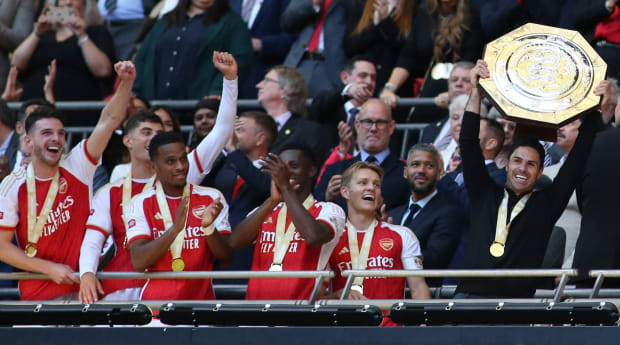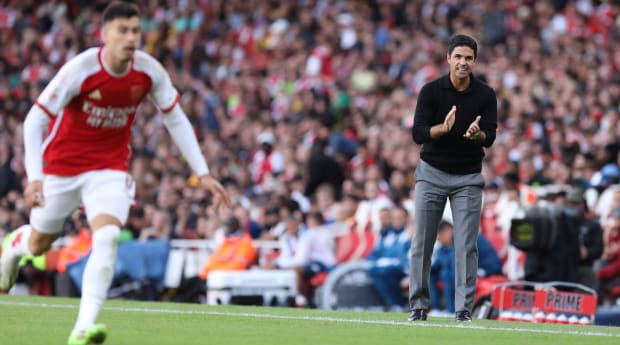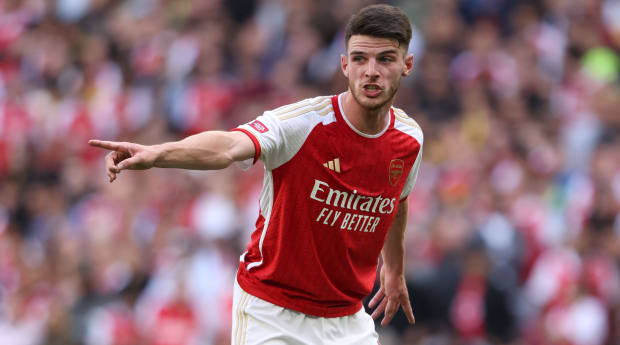It’s a Tuesday afternoon in the U.S., and Declan Rice is excited to be here. “Very excited,” actually, he says.
“Here” does not necessarily mean the preseason American tour where he made his Arsenal debut in front of a sellout crowd at D.C. United’s Audi Field. The Gunners’ newly minted £105 million ($133.2 million) transfer from West Ham, now the most expensive British player of all time, is referring to his new London club.
“It’s been a big transition the last couple of days,” Rice says. “Obviously used to one way of playing and coaching for so long. So to now come to a new manager, new team, new ideas … I’ve learned so much already.”
He’s not the only Arsenal player entering the season with some newfound knowledge. The 2022–23 season was a wild ride for a team that began to reach its potential far earlier than expected, then faded down the stretch.
It was also the culmination of a rebuild of dramatic proportion and bold commitment to its manager and players. Now, after a season where the team’s young core learned what it took to be one of the world’s best was followed by an offseason of key additions, Arsenal appears poised to take over.
Mikel Arteta, the midfielder, and Arsenal always seemed like the right fit. It was Arteta who arrived just after an 8–2 thrashing at the hands of Manchester United in Matchweek 3 of the 2011–12 season and effectively settled the midfield. It was the Spaniard who grew close to then manager Arsène Wenger, was named captain in his fourth season with the squad and gave an emotional farewell after his final match with the Gunners.
So it seemed almost inevitable that Mikel Arteta, the manager, would find his way back to north London. And it didn’t take long. Arteta immediately joined Pep Guardiola’s Manchester City staff after his playing career finished, and after Arsenal passed on him in the summer of 2018 in favor of Unai Emery, the job was open again just 18 months later. This time, both club and coach were ready.

IMAGO/Sports Press Photo
Arteta inherited a squad filled with transfer-market misses and academy products who weren’t quite ready for the big stage. But just as Arteta had a stabilizing effect on Arsenal when he arrived as a player in 2011, his return as a manager did, too. Arsenal lost just two of its next 16 matches and climbed from 12th to eighth in the league.
Arteta’s ethos was about building a unified front from the start. It’s why, when the Gunners were 15th in the league table in December 2020, there was no bending to the will of the pressure cooker of public perception. It’s why three successive goalless losses to start the ’21–22 campaign weren’t followed by a panicked dismissal of the coaching staff. And it’s why the trusting of young players—namely Gabriel Martinelli and Saka—helped turn an inexperienced squad into a youthful powerhouse.
Martinelli says he knew they were building to something special during the 2021–22 season. He once claimed Arsenal would soon be one of the best teams in the world. Martinelli’s prophecy took time and patience, and it still has some way to go. But it’s under Arteta’s tutelage that it is happening, through a balance of structure and flexibility, of tactical innovation and creativity.
“He gives you freedom to do what you are good at,” Martinelli says. “He’s so good at this. He always tries to play us … where we can be more dangerous.”
Arsenal’s commitment to its former player turned manager finally paid dividends last season. It was clear late in his playing career and in his stint with Manchester City that Arteta had the mind to be a top-level manager (Guardiola, the great tactician himself, said recently, “Maybe I learned more off him than he did off me.”) After three years of squad building, Arteta’s tactical innovations could be unleashed.
What was a gradual build seemed to all come together at once. Martinelli, the once-unheralded young player bought for just £6 million, roared out to a career-best season with 15 goals and five assists. Granit Xhaka’s Arsenal career was revived from what seemed to be an ignominious end to a remarkable season in a more forward-thinking midfield role. Captain Martin Ødegaard, cast away from Real Madrid, became the missing creative link between midfield and attack that had been needed for years. And Saka completed his arc from academy product to global superstar.
“You can’t describe it. It’s a transformation,” says Saka on being coached by Arteta. “A transformation in the way you see football, the way you understand the game. … You know straight away what you need to develop and how you can help the team the best.”
Rice says that a “massive” reason he chose to join the north London giants was because of the level of coaching he’d get. Speaking just days after his transfer was made official, Rice just shakes his head when discussing what he’d already learned from Arteta.
“I’m just blown away,” he says.
Try finding someone who can poke holes in Saka’s skill set. It’s not easy. The 21-year-old’s rapid ascension into one of the world’s best wingers is backed by logic even rivals can’t ignore: The only players with more Premier League goal contributions last year were superstars Harry Kane, Mo Salah and Erling Haaland.
Saka’s rise coincided with Arteta’s arrival. When Saka was in his first full season as a first-teamer, Emery had largely played him at his preferred position on the wing, and the 18-year-old had shown flashes (a goal and two assists in a Europa League win over Eintracht Frankfurt) but was primarily a rotational option. Arteta quickly slotted him in as one of the team’s primary fullbacks, where Saka’s overlapping runs and crosses netted him a team-high 11 assists across all competitions.
“I’ve learned a lot about how wingers in the Premier League play against defenders and how to position myself,” he said at the time.

IMAGO/ZUMA Wire
Saka graduated from the school of wing play midway through the ’20–21 season. Arsenal was winless in its previous seven matches heading into a London derby against fifth-place Chelsea. The £72 million Nicolas Pépé project had ostensibly failed. Arteta placed Saka on the right wing, and he ran with the opportunity, scoring once and creating havoc on that side.
The Gunners surged from 15th to eighth place by season’s end. Saka racked up six goals and five assists in all competitions to finish the year—and, notably, the team entrusted the then-19-year-old to start all but five of the final 24 league matches. Another campaign came and went without landing a coveted Champions League spot, but the young winger was a sign of hope that a young core was growing.
Meanwhile, Saka’s play earned him his first England call-up in the months before the 2021 Euros. He apparently impressed manager Gareth Southgate enough in just five appearances to earn a spot on the highly talented squad for the tournament. Saka started three matches and featured in the final, a match that was marked by the saved penalties of Saka and fellow phenoms Jadon Sancho and Marcus Rashford. But the experience of playing the game at the highest level as a teenager was another notch in the belt of Arsenal’s young hope.
“Just the opportunity I’ve had from [Southgate and Arteta] to play a lot of football has helped me the most,” Saka says. “Learning by making mistakes has been the most important thing for me. I feel like I’m a completely different player from the player that I was three years ago.”
So Saka’s true breakout didn’t come as a surprise to many. After bagging 11 goals and seven assists in 2020–21, he was ready to emerge as one of the Premier League’s best attackers last season. A supercharged young Arsenal attack, led by Saka, Martinelli, Ødegaard and summer signee Gabriel Jesus, took full advantage of Arteta’s free-flowing system. Saka, the face of the team’s youth movement, had arrived.
“He’s a lovely guy,” Jesus says. “I can see in him hunger. … He wants to improve. He wants to break all his own limits.”
You’d be hard-pressed to find someone with anything but praise for Saka’s demeanor off the pitch. Martinelli has been the England star’s teammate since his arrival at Arsenal from Brazilian club Ituano in 2019. When asked about what it’s been like to grow up as a player alongside Saka, Martinelli doesn’t even mention his game.
“It’s been a pleasure.” Martinelli says. “Everyone loves him. Everyone in England and the world loves him.”
It’s now Saka’s time to shine. He says there’s no specific moment when he felt the club’s rebuild came to fruition, but last year’s second-place finish was instead the result of slow and steady progress. The 2022–23 season gave him and other academy products and young players the club developed (Martinelli, Reiss Nelson, Eddie Nketiah) a chance to play in some of the highest-pressure moments club soccer has to offer. But Saka’s growth is a culmination of the club’s commitment to a true developmental rebuild, a human personification of the team’s grind from mid-table to top-tier.
The weight of lofty expectations is nothing new for Jesus. The Brazilian made a £27 million move from hometown club Palmeiras to Manchester City at just 19 years old and notched seven goals and four assists in his first 10 Premier League appearances. Jesus seemed the logical successor for aging club legend Sergio Agüero. City soon began its era of domestic dominance, winning two straight league titles before a second-place finish to Liverpool.
Jesus and former City teammate Oleksandr Zinchenko joined Arsenal last summer after winning four Premier League titles in five years. It’s trite to say the duo knows what it takes, but as Jesus says, he’s been perched atop the league table before.
“You cannot sleep,” he says. “If you sleep for one game, you can lose the league. … The Premier League is the hardest and best league in the world. It’s so competitive. Everyone can win games.”

IMAGO/Uk Sports Pics Ltd
Last year’s Arsenal squad had that lesson handed to it on a sky-blue platter. The Gunners spent 248 days atop the table. Three consecutive draws and a thrashing at the hands of eventual champion Man City in May were all it took to crash-land on a second-place finish.
Injuries played their own role in the home stretch: Center back William Saliba and right back Takehiro Tomiyasu left holes in defense when they both missed the last two months of the season. It was a teaching moment for a squad whose rebuild had rapidly transformed into on-pitch success.
“It was 99% a good season,” Jesus says. “This season, [we’ll come] more prepared, now with more experience and feeling more the smell of the title.”
Arteta & Co. certainly didn’t waste time looking back at the failed title charge. The second-place league finish means Arsenal is back in the Champions League for the first time since 2016–17, and it celebrated its return with a summer spending spree. The Gunners reached across London to acquire Chelsea forward Kai Havertz for a reported £65 million before splurging on Rice. It was a departure from the typical transfer-window bargains the club’s fans had grown accustomed to—it was buying depth behind strength and matching the spending of the world’s richest teams.
The two signees, along with Ajax defender Jurrien Timber (£34 million), add a level of versatility the club hasn’t had in years past. It’s a quality that befits Arteta’s system—just ask Leandro Trossard. The Belgian forward arrived in last year’s winter transfer window after his tenure at Brighton had soured; Trossard had reportedly been involved with a spat with another player on the training pitch and was frozen out by manager Roberto De Zerbi.
Arsenal’s move for him was relatively low-risk for the budget (£27 million), but a midseason addition that left his old club on bad terms could be a risky proposition for a cohesive squad. Yet Arteta used Trossard’s unique versatility, and the fit was perfect; the 28-year-old immediately became a key rotational player, playing all roles across the front line and midfield. He racked up 11 assists in 20 appearances, 0.97 assists per 90 minutes played.
“I’ve been playing in a lot of roles, but I don’t really mind,” Trossard says. “I can play everywhere up front, as a 10 as well. I’m good between the lines, so I love to play with my back towards the opponent’s goal.”
Joining him is the divisive Havertz, who’s either a unicorn or tweener, depending on who you ask. Not unlike Trossard, his versatility allows him to play as a No. 9, winger or in the midfield, and he earned a reputation for showing up in big games, namely by scoring the winning goal for Chelsea in the 2021 Champions League final. But Havertz failed to nail down a spot at any one position and, unlike Trossard, he struggled with inconsistency, leading to only 19 league goals in three years with the Blues.
Somewhere behind them both is likely where Rice will reside. He ascended at West Ham primarily playing in a defensive midfield role, but he was all over the pitch last season, scoring a career-high five goals in all competitions, and he even slotted in as center back earlier in his career.
“Anywhere in midfield, to be honest with you,” says Rice on where he feels most comfortable. “Last season I played quite a lot [of] box-to-box. With England I always play as a holding midfielder. I know we have other top midfielders as well, and the manager likes to change and adapt. So I’m open to playing anywhere. I think I have different qualities to the other midfielders that we have here.”

IMAGO/Paul Marriott
Either way, Rice says he’s committed to providing cover for his longtime England compatriot and new club teammate.
“I’ll just say to [Saka]: ‘Bro, go and attack, and I’ll just defend for you,’” Rice says with a laugh.
“See, I love that,” says Saka, sitting next to him.
It was reported that Rice was Arteta’s No. 1 target to improve the midfield for long before this summer. Now they have him. They have the young stars. They have the high-pressure experience, the manager, the world-class talent, the versatility and the cohesion. After last year’s push for trophies came up short, can anything slow down Arsenal?
“We have a saying in the team, you’re either under pressure or you feel under pressure,” Saka says. “I feel like this season, we’ve learned our lessons and we’ll be back.”







